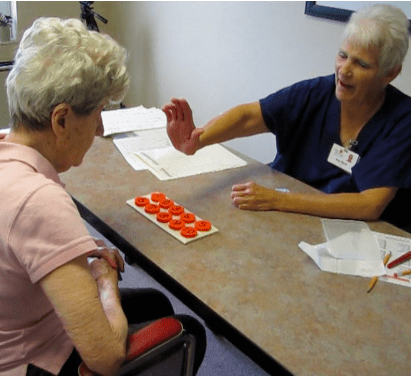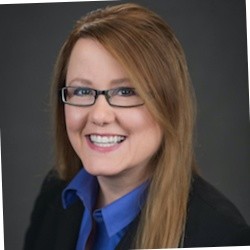The elusive high five
It was an almost-perfect day, and I have only myself to blame for any deficiencies. One clear memory involves not what I did, but what I wasn’t able to do.
 It was an overcast but pleasant morning Aug. 13 when I got into my car and drove to the Renaissance Retirement Community of the Eliza Jennings Senior Care Network to see SAIDO Learning in action. Two of my Long-Term Living colleagues and I had visited another community in the network, the Eliza Jennings Home, the previous day as part of our efforts to produce a comprehensive package of information about our 2013 OPTIMA Award winner for all of you in the long-term care industry. There, some Eliza Jennings employees had shared with us the story of how the Alzheimer’s- and dementia-fighting program had come from Japan to the United States, and they also told us of their experiences witnessing its effects on those with cognitive difficulties.
It was an overcast but pleasant morning Aug. 13 when I got into my car and drove to the Renaissance Retirement Community of the Eliza Jennings Senior Care Network to see SAIDO Learning in action. Two of my Long-Term Living colleagues and I had visited another community in the network, the Eliza Jennings Home, the previous day as part of our efforts to produce a comprehensive package of information about our 2013 OPTIMA Award winner for all of you in the long-term care industry. There, some Eliza Jennings employees had shared with us the story of how the Alzheimer’s- and dementia-fighting program had come from Japan to the United States, and they also told us of their experiences witnessing its effects on those with cognitive difficulties.
See related content:
2013 OPTIMA Award: The gift of the present
SAIDO Learning: Seeing is believing [PODCAST]
SAIDO Learning: 'It's remarkable' [PODCAST]
The Cleveland area senior living organization won this year’s OPTIMA Award for the clinical testing it conducted to assess the program’s effectiveness before implementing it throughout its network. The day of our visit to the Eliza Jennings Home, the network finalized an agreement with the program’s overseas developer and now will serve as a training facility so that other senior living organizations can sublicense and offer the program at their sites around the country. But because the Cleveland area network currently has the only U.S. communities in which SAIDO is practiced, we geared our efforts not only toward the clinical trial but also toward explaining the program generally and in detail for all those who might be interested in it.
It was energizing to spend time with those working with the residents in this way, and the next step was to actually see the program with my own eyes. My visit to the Renaissance was a mission to capture a SAIDO session on video and in photos so that you, too, could gain a better understanding of it. I went alone, excited and armed with a suggestion from the editor-in-chief: to obtain a photo of a staff member (or supporter, in SAIDO speak) congratulating a resident (learner) at the end of a session via a high five, if possible. From our research, we knew that the odds were good that a hand-slapping exchange would occur.
I’ve been a journalist for longer than I care to admit—interviewing, writing, recording, photographing, etc. I’ve appeared on live television and in videos and have coordinated audio podcast projects, but shooting video? That was a new and exciting opportunity for me that day (unless you count the time my brother handed me his video camera at one of his children’s birthday parties).
The camera I took was easy to operate, and as I moved between the three tables at which participants were seated, I alternated between taking photographs and shooting video with the device. I even managed to take a photo of a high five that occurred at one table while the camera was set to photo mode (that one ultimately found its way to the opening spread of our print edition article—see page 17).
 All was going well, and then, around the 30-minute mark, as the brain exercises wrapped up at another table, the supporter at the table in front of me put her hand up and asked the learner to give her a high five. My mind raced. The camera was in video mode, but I wanted to capture this brief encounter in a photo. I quickly switched the camera to photo mode to freeze the interaction in time. (Could I have isolated a frame from the video to use as a photo? Yes, but that fact didn’t occur to me in the heat of the moment.) In the process, I did not get the photo, nor does the celebratory exchange appear at the end of the video I was shooting, thanks to my mode-switching move. But I did capture it in my mind, and fortunately, you can see the preceding part of the session here (you’ll note the supporter raising her hand and encouraging the same from the learner at the end of the third video posted). A screen shot of the video appears above.
All was going well, and then, around the 30-minute mark, as the brain exercises wrapped up at another table, the supporter at the table in front of me put her hand up and asked the learner to give her a high five. My mind raced. The camera was in video mode, but I wanted to capture this brief encounter in a photo. I quickly switched the camera to photo mode to freeze the interaction in time. (Could I have isolated a frame from the video to use as a photo? Yes, but that fact didn’t occur to me in the heat of the moment.) In the process, I did not get the photo, nor does the celebratory exchange appear at the end of the video I was shooting, thanks to my mode-switching move. But I did capture it in my mind, and fortunately, you can see the preceding part of the session here (you’ll note the supporter raising her hand and encouraging the same from the learner at the end of the third video posted). A screen shot of the video appears above.
You’ll have to trust me that the sweet interaction occurred; the learner did raise her hand to meet the hand of the supporter. I’m sorry that the camera missed it, but I’m pleased that we at Long-Term Living are able to provide you with the comprehensive package about SAIDO that we set out to produce. I hope the videos and other materials give you a detailed understanding of this special program and the people involved with it. After all, it’s not about me and my recollections. It’s about those with dementia and Alzheimer’s disease and what can be done to help them preserve more of their memories.
Access all blogs by this author.
Related OPTIMA Award winner coverage:
2013 OPTIMA Award: The gift of the present
How SAIDO Learning works
The SAIDO clinical trial
SAIDO Learning: A timeline
One-on-one with… Chelley Antonczak
SAIDO Learning in action: A typical session [VIDEO]
SAIDO Learning: Seeing is believing [PODCAST]
SAIDO Learning: 'It's remarkable' [PODCAST]

Lois A. Bowers was senior editor of I Advance Senior Care / Long-Term Living from 2013-2015.
Related Articles
Topics: Alzheimer's/Dementia , Clinical , Executive Leadership











